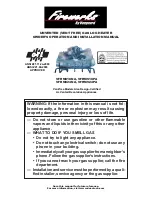
37
GP-MSET-EX-6A
SET(U) / ITT(U) Manual
RD: MAY 2009
RL: 06A - BA
LOW/ UNSTEADY FLAME CURRENT
If the current to the S87 flame circuit is less than 1.5
µA or is unsteady, check the burner flame, flame sen-
sor location and electrical connections as follows.
Electrical Connections and Shorts
Connections at the flame sensor must be clean and
secure. If wiring needs replacement, use moisture
resistant #18 wire rated for continuous duty up to
221
0
F [105
0
C].
Flame Sensor
The flame signal is best when about 1 in. [25 mm] of
flame rod is immersed in the burner flame. A bent flame
rod, bent mounting bracket or cracked ceramic in-
sulator will affect flame signal.
Replace flame sensor if necessary.
Burner Flame
The flame sensor must be constantly immersed in
flame. Check burner flame condition as shown op-
posite. Observe burner rating plate for the correct
gas pressure, and check with a manometer. If gas
pressure is correct check line and orifice for ob-
structions.
23. FLAME SENSING CIRCUIT
The output of the flame sensing circuit cannot be checked directly on the S87 body.
Check the flame sensing circuit directly by checking the flame sensing current from the
sensor to the S87 as follows.
1. Connect a meter (dc microammeter scale) in series with the flame signal ground
wire as shown below. Using the Honeywell W136A Test Meter or equivalent.
Disconnect the ground wire from the S87. Connect the red (positive) meter lead to the
free end of the ground wire. Connect the black (negative) meter lead to the quick-
connect ground terminal on the S87.
2. Restart the system and read the meter. The flame sensor current must be at least 1.5 uA
and steady. If the reading is less than 1.5µA
or unsteady, see LOW OR UNSTEADY
FLAME CURRENT section, below.
If a flame is present at sensor and a reading of zero uA is obtained, check for a
secondary ground connection to the 24V (GND) terminal. If secondary connection
exists, temporarily remove connection and measure flame current.
A good rectifying flame is achieved
with approx 1” of sensor in a strong
blue flame, positioned 1/4” to 1/2”
away from flame source surface.
A lazy or weak flame is not a
good rectifying flame.
Check gas pressure and gas ori-
fice for insects, and spider webs.
1.5 µA DC
minimum
and steady
1”
1/4” to 1/2”
















































